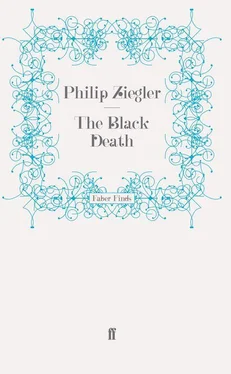8. PROGRESS ACROSS THE SOUTH
Of which 22nd yeare and the next of the king’s raigne is little to bee written, nothinge being done abrode, in effect, through the great mortality of the plague that raged all over the land; which as the historiographers of that time deliver, consumed nine parts in ten of the men through England, scarce leaving a tenth man alive. {256}
For the historiographer concerned with the Black Death in England, 1349 is a year of which there is much to be written, for it was in the course of this year that almost every town and village was afflicted. At first it is possible to visualize the plague conducted, as it were, like a military operation. The initial attack on the Dorset ports; the bold thrust across country to the north coast so as to cut off communications between the western counties and the mainland; seaborne landings at points along the coast to outflank the defence; the slow mopping up of what opposition was left in Devon and Cornwall; and the main thrust towards the Thames valley and London. But after March 1349 the analogy with a controlled campaign can no longer be pursued. To change the metaphor, the dykes were down and the water was everywhere. The infection no longer advanced regularly from point to point but sprang up simultaneously in a hundred places; reaching its peak, for no reason that can be established, in Norfolk and Suffolk before Cambridgeshire; in Hampshire before Surrey; in Warwickshire before Worcestershire. By July it was spreading across the northern counties, by the end of the year nowhere had been spared. Through winter and summer, through flood and drought; against old and young, weak and strong; the disease went imperviously on its way. To track its course with any precision would be a hopeless task: the most that is possible is to register its impact in the various regions and to highlight its workings at a few points where fuller detail is available.
When the plague turned eastwards after reaching the Bristol Channel the first city to be threatened was Gloucester. The town council, horrified at the tragedy which had overtaken their neighbours in Bristol, decided to seek refuge in isolation. An embargo was placed on all intercourse between the two cities and the gates closed to any refugees who might carry with them the seeds of the plague. {257} But even if it had been possible to keep out every infectious human, and there is no doubt that the plague had been present in Bristol in its most virulent and infectious form, the citizens of Gloucester could have done nothing to protect themselves from the plague-bearing rat, making its way along the ditches or travelling in the river boats that plied up and down the Severn.
Bishop Wulstan Bransford remained on his country estate, occupied in the endless search for new priests to take the places of the dead. Between March and September alone eighty vacancies had arisen, almost all caused, according to the County History, by the death of the previous incumbent. {258} The Bishop himself died on 6 August 1349. At Ham, a manor belonging to the Berkeleys not far from Cheltenham, so much land either escheated to the lord because of the tenants’ death without an heir or was abandoned to look after itself that the bailiff had to hire the equivalent of 1,144 days’ work to get the harvest in. The figure is impressive but so also is the fact that the extra labour was forthcoming, though no doubt at a considerable price. {259}
* * *
In so far as any pattern can be detected in the advance of the plague from west to east across England it seems to have struck from Bristol into Oxfordshire, Berkshire and Buckinghamshire and from Southampton and the West across Hampshire, Wiltshire, and Surrey towards London. The first prong of the advance provided some of the most fearful devastation of the whole epidemic.
The worst months for Oxfordshire were March, April and May, though there must certainly have been many cases before and after this period of maximum destruction. The county was, at this time, an archdeaconry within the vast diocese of Bishop Gynewell of Lincoln. Professor Hamilton Thompson’s enormously valuable analysis of the Registers of the diocese shows that, so far as mortality among the clergy is concerned, the south of the county escaped lightly. In the deanery of Henley only a quarter of the beneficed clergy died and in Aston a mere 19 per cent. But in the city of Oxford itself, 43 per cent did not survive, in the deanery of Woodstock 42 per cent, in Bicester 40 per cent and in Chipping Norton 29 per cent. In the whole archdeaconry just over 34 per cent of the beneficed clergy perished, well below the 40.7 per cent which was the average for Gynewell’s diocese. {260}
Applying the suggested margin of error, one arrives at the highly speculative conclusion that total mortality in the archdeaconry should have been between 25 per cent and 37 per cent. The Cartulary of Eynsham Abbey provides evidence to show that, in that part of the county at least, the lower of these estimates was well below the mark. {261} The Abbey itself, between Witney and Oxford, seems to have suffered badly enough. Abbot Nicholas had been deprived of his office by the Bishop because of some now forgotten offence. Bishop Gynewell nominated two administrators to look after the Abbey pending the nomination of a new Abbot but on 13 May two of the senior brethren arrived to report that the first of his nominees was dead and the life of the second despaired of. He named in their place the two monks who had brought the news and sent them on their way. His new appointments met with no greater success; both monks were dead before they reached the Abbey. In despair Abbot Nicholas was forgiven and reinstated.
But the manors of the Abbey suffered still worse. Common tradition in England ascribes to the Black Death the responsibility for the disappearance from the map of many villages, leaving the church, usually the only solidly constructed building, as a solitary monument to the past. Certainly the Black Death helped the process of depopulation and so weakened many communities that they were unable to survive the economic and social vicissitudes of the next two centuries. But very few villages can be shown to have been finally and completely deserted as a direct result of the Black Death. {262} One of the exceptions was the Abbot of Eynsham’s manor of Tilgarsley (or Tilgardesle) where the collectors of the lay subsidy reported in 1359 that it was not possible to gather the tax because nobody had lived in the village since 1350. There is no reason to think that Tilgarsley was either rich or thickly populated before the Black Death but the fact that the tax was fixed at 94s. 10d. suggests that the community was reasonably prosperous or, at least, far removed from starvation. {263}
Another Eynsham manor, that of Woodeaton, went near to sharing the fate of Tilgarsley. ‘In the time of the mortality of men or pestilence which befell in the year of our Lord 1349’, reads the Cartulary, ‘scarce two tenants remained in the manor and they would have departed had not Brother Nicholas of Upton, then Abbot, …made an agreement with them and the other tenants who came in afterwards.’ The bargain which the Abbot struck, giving the tenants a somewhat higher rent but less arduous feudal services, is an interesting example of the methods to which landlords were to have recourse in the years following the Black Death. He was only partially successful. By 1366 there were twenty-seven tenants in the village but six cottages still stood vacant.
At Cuxham, some seven miles south of Thame, only two reeves had been appointed to administer the manor in the whole period between 1288 and 1349. The old reeve died in March 1349. His replacement died in April. His successor, a bailiff, died in June. His further successor died in July, and the fifth in line died or, at least, departed from the scene a year later in July 1350. By 1360 the lord had given up any attempt to farm the manorial demesne and was seeking to put all his land out to rent. {264}
Читать дальше












